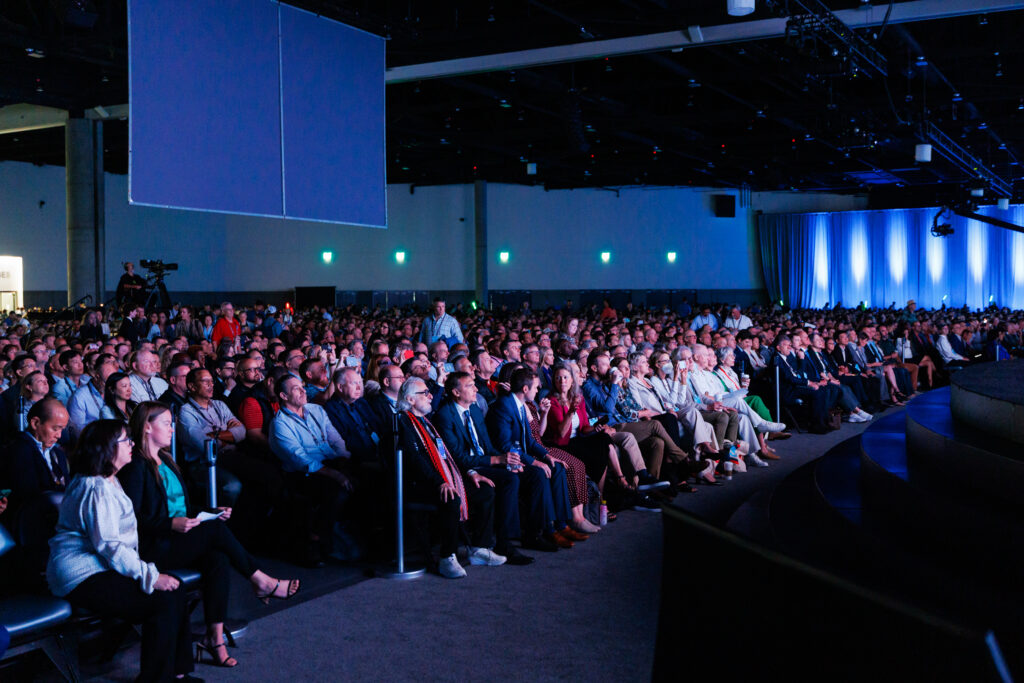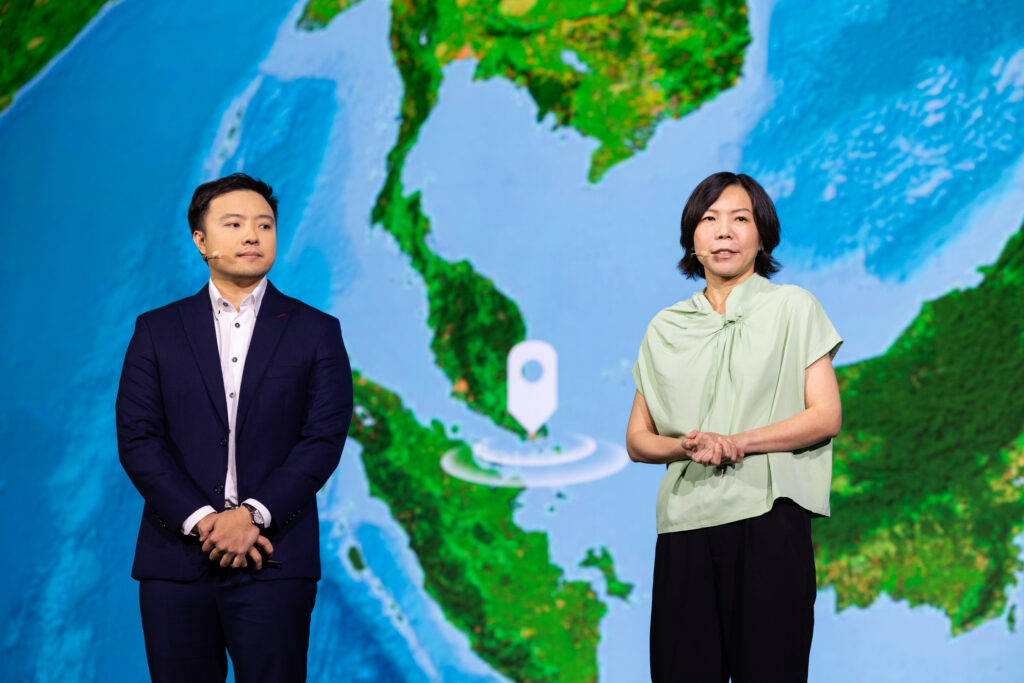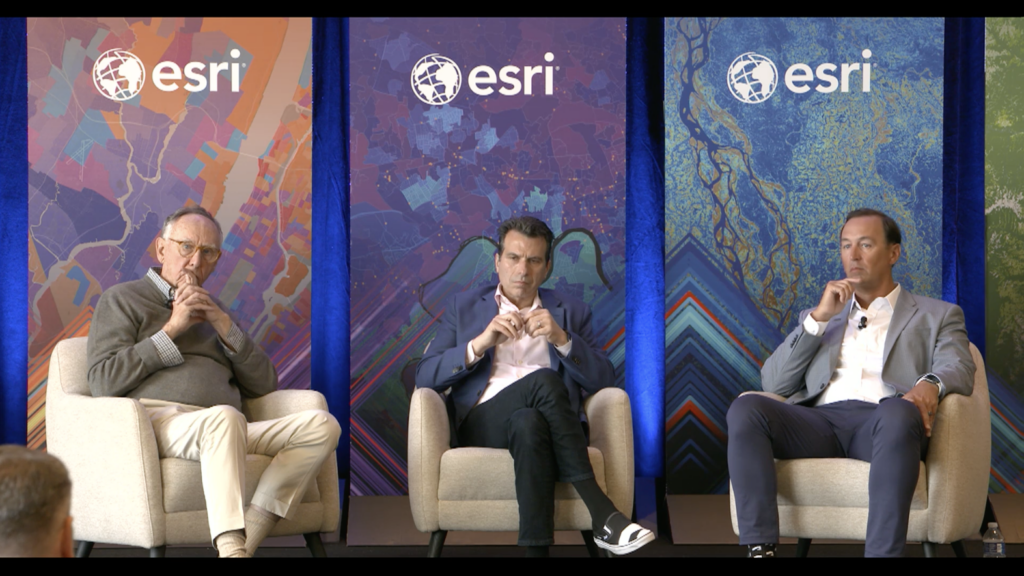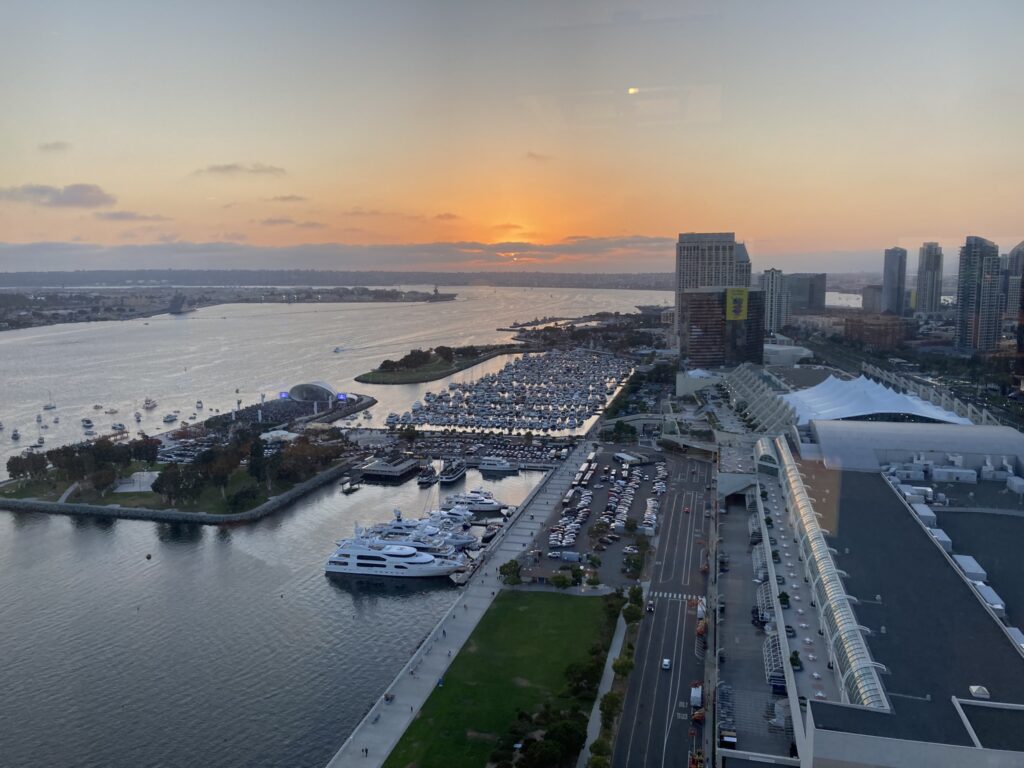It must seem to many attendees at the Esri International User Conference that it’s an advantage to live in San Diego. Well, it’s a mixed blessing. Driving the 26 miles to the opening event, on a Sunday evening, took almost an hour, because the road was being dug up outside the San Diego Convention Center. Parking cost $45, because on the same evening there was a Stick Figure concert at the magnificent Rady Shell outdoor music venue. A challenge, therefore, to arrive in time for the opening of the program Esri had laid on for media people. Nevertheless, the views over San Diego from the high floor event venue were staggering as we enjoyed one of San Diego’s magnificent sunsets. Brian Cross, Esri’s Director of Professional Services, made some brief remarks, one of which stood out for me in terms of the evolution of GIS (and ArcGIS in particular): whereas GIS has undergone many major transitions over the decades, such as the evolution from desktop to web services, and the accompanying democratization of GIS processing from expert users to a massive community, the current direction is exciting – at the enterprise level, IT and GIS are coalescing, customers are managing GIS differently, so mapping is becoming standard fare for more people.
Jack Dangermond, president and founder of Esri, addresses attendees of the firm’s 44th annual user conference in San Diego, California.
The house that Jack built
Esri is 55 years old and this was its 44th user conference. The attendance was 18,162 on-site from 147 countries and 14,533 remotely. My thanks to Robby Deming, Esri’s Senior Media Relations Strategist, for the statistics, some of the photos that appear in this article, and various opportunities that he made available during the event. As always, we streamed in for the opening plenary imbued with anticipation. As always, it was magnificently orchestrated and emceed by Jack with his usual gentleness and mastery. Doubtless attendees would take home different memories, but one of mine was a presentation by NParks from Singapore, which won an award. The green portions of Singapore are regarded, almost reverently, as key to the quality of life, so NParks keeps minutely detailed data. As a result, every tree is laser scanned from time to time – I am in contact with them to solicit an article, since the amelioration of urban heat islands will become more and more vital to the citizenry as global warming accelerates.
In the afternoon, one of the speakers was a gentleman from Minnesota, using maps to illustrate the rationale behind and the success of several public policies[1]. Yes, it was Governor Tim Walz … we’ve heard a lot more about him since. Just before he rushed off, Governor Walz introduced the high-schoolers and their teacher who were about to present the next part of the plenary – heart-warming and appropriate, as the Governor was a high-school geography teacher too. I doubt if anyone takes the opening plenary for granted and I exited the hall marveling at Esri’s achievements and growing role.

Esri User Conference 44 session attendees, day three.
There were many fine exhibits at the Map Gallery reception, but there were also two large booths. One was GEOSA, the recently re-named national mapping agency of Saudi Arabia, pitching not only the virtues of the Kingdom and GEOSA’s accomplishments, but also its bid for the XXVI Congress of ISPRS in 2030.
Esri communications folk always organize a magnificent program for us persons of the press. We were taken on a short tour of the exhibition floor shortly before the show opened, but there was just too much to absorb – our whistlestop visits to Autodesk, Fulcrum and Trimble were almost too short to be meaningful – and my most vivid memory is of the reaction of a security guards’s dog when it encountered a robot dog walking down one of the aisles! In addition, there was an excellent press event on indoor mapping, with speakers from Langan, NBC Construction & Engineering, and Hartsfield-Jackson Atlanta International Airport. I approached the speakers about writing articles for us, as well as Jennifer Hill, Esri’s Group Product Manager! I think the message here is that forward-looking organizations have already embraced indoor GIS and digital twins and invested heavily in them for data acquisition, processing and management. Another event laid on for the press was a presentation by Old Dominion University and NOAA about sea level rise around Hampton Roads, Virginia, using VR to facilitate awareness – lidar-free, but salutary and fascinating nevertheless.

Presentation from members of NParks Singapore.
The busy program also included an OGC meet and greet, chaired by new CEO Peter Rabley. I liked Peter’s comments about accelerating the OGC process, spending members’ money wisely and so on. Unfortunately, I had to leave just as the discussion was opening out, because I had an appointment with Trimble leadership back in the exhibition hall.
Thanks to the magic of Stacey Hartmann, I had 30 minute with three important folk from Trimble. Lee Braybrooke, Global Business Development Director (GIS), and Gareth Gibson, Marketing Director, Mapping & GIS. Earlier in the day, I had attended a session entitled, “Accuracy matters – innovations for ArcGIS field operations from Trimble and Esri,” in which Lee and Gareth had given a smooth, compelling duet. Knowing a little about LIDAR Magazine, they didn’t beat about the bush, starting our meeting with “high accuracy reality capture … accuracy is a core value proposition … complementing and replacing boots on the ground.” The costs of reality capture have fallen and Trimble aims to help this through one-stop shopping.Trimble’s emphasis is on deliverables rather than raw data, as well as the easy injection of data into the Esri environment.
They explained Trimble’s strength in depth in GNSS, including of course the Applanix part of the company. They focused on one innovative, important part of Trimble’s substantial portfolio of GNSS products and services – Catalyst, an “ecosystem service”. I understood and liked this: the customer purchases a DA2, which is a $500 GNSS antenna on a pole with a basic accuracy of 2 m, then buys a service. The price of the service increases according to the precision and accuracy required by the user and it can be purchased for an hour, a month, a year. I was educated before GPS was invented, so I am no expert, but it seemed to me that Catalyst would work, be economical, but would be a bit of a jump for users accustomed to owing much more expensive hardware. They agreed that there had been some initial resistance but as the message sinks in the adoption grows. Verticals attracted to it include agriculture, utilities and land management. I was not surprised by the phrase, “democratize high accuracy”. They claimed jobs could be done faster. Intriguingly, one of the applications they cited was the measurement of GCPs for UAV-photogrammetry and UAV-lidar – no discussion from these guys about the value of GCPs! Trimble rightly recognizes that UAVs are being deployed in all environments, with a growing range of sensors.
Joe Blecha, Trimble’s Director of Product Marketing, leads the direction of desktop and cloud-based workflows for geospatial, survey and civil construction customers. We started in a favorite place for me – Inpho photogrammetry. Inpho, a photogrammetry software company founded by the late, revered Fritz Ackermann, was acquired by Trimble in 2007. The software is still going strong, remarkable for its depth and strong customer support, but Trimble is pivoting it towards the rapidly growing Trimble Business Center (TBC) to make it more accessible. Joe was proud that Caltrans uses the Inpho capabilities in TBC: there are around 1000 commands, covering extensive photogrammetric and lidar functionality. We could have talked about this for hours, but the conversation widened into other aspects of TBC, for example oblique imagery (MATCH-3DX in the latest version of the Inpho software), structural inspections and ease of use. TBC now, for example, includes AI-based point-cloud classification.
He spoke to me about Trimble Business Center’s evolution and the latest features in its office-to-field workflows, including Trimble Connect, transportation infrastructure industry initiates such as paving/milling work, and AI for feature extraction/pavement analysis.
As I was leaving the show floor, I noticed that Wingtra was showcasing the lidar capability it added at the beginning of this year. Finally, I was delighted to see ChangeAerial, the small company founded by my friend emeritus professor Doug Stow from SDSU, in the start-up area.
On the Thursday morning, there was a press conference that the Esri communications team had emphasized would be of great importance. Jack was in conversation with Autodesk CEO Andrew Anagnost and Adam Horn from Kansas City firm HNTB. Both CEOs emphasized the closeness of a relationship that has blossomed since they met. Anagnost put it well, “There are only a few partners that we’re dependent on to get things done.” Esri don’t do CAD, Autodesk don’t do GIS, but at enterprise level companies need to be able to move data seamlessly and felicitously between the two environments. Both companies strive to make this happen. Jack expressed it as a system of systems – two private companies are doing far more in the public interest than just exchanging data. The partnership is geospatially enabling Autodesk workflows, with maps inside. It provides environmental and social contexts for design, a system of record, the management of assets, and the digital twin. This is what makes the relationship unique, though of course Autodesk and Esri have multiple critical relationships, for example with Microsoft and Amazon, but these are not quite the same. The Autodesk-Esri relationship is not contractual and money doesn’t change hands.

Jack Dangermond in conversation with Autodesk CEO Andrew Anagnost and Adam Horn from HNTB.
Adam pointed out that the GIS/BIM integration helps AEC firms as infrastructure ages and digital transformation is no longer an option. Stovepiping will be reduced. “With public organizations, data is the currency of the digital transformation.” The infrastructure challenge is almost too enormous to appreciate, but Anagnost brought it home in a personal way by expressing some feelings of nervousness on his daily commute on the BART. Adam reminded us that in 2017 the US national bridge inventory rated half the nation’s bridges as structurally deficient. HNTB is pioneering “rapid design”. Firms need highly collaborative, integrated teams.
The panelists answered various questions from media people in a straightforward way. Anagnost said that the fundamental work had been done and interoperability exists, so the next step is specific workflows. There was a question about institutionalization. Interestingly, it was revealed that Tim Walz had attended the Senior Executive Summit held the day before the main conference. Interestingly, Jack said that the Autodesk-Esri relationship is an example of “tech companies taking responsibility for the future.” Finally there was some discussion on AI and XR – the companies regard these as highly important and are working on them, as we knew – they are already highly beneficial.
This press conference was a good session, but I had been wondering, would it contain an even bigger announcement, the biggest announcement, which people have been speculating about?

Sun sets over the Marriott Marquis San Diego Marina, directly adjacent to the San Diego Convention Center.
I learned from an Esri insider that Esri’s relationship with Adobe is becoming closer too, though it’s not quite like the Autodesk one. Again, these firms are not competitors, but are stronger together. Moreover, such alliances make the words of Brian Cross (see above) all the more realistic.
The exhibition was big and bright as always, but remember that it differs from other geospatial conferences because half the space is allocated to Esri. As always, Esri experts spent the week deep in conversation with customers from all over the world. Their enthusiasm and their culture bear no equal.
###
[1] This is described by a professional journalist, far better than I could do, in: Ingraham, C., 2024. Former geography teacher Tim Walz is really into maps, Nevada Current, 7 August 2024. https://nevadacurrent.com/2024/08/07/former-geography-teacher-tim-walz-is-really-into-maps/
The post A Tale of Two GIs appeared first on LIDAR Magazine.


